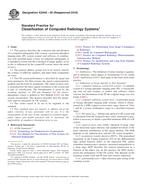Potřebujeme váš souhlas k využití jednotlivých dat, aby se vám mimo jiné mohly ukazovat informace týkající se vašich zájmů. Souhlas udělíte kliknutím na tlačítko „OK“.
ASTM E2446-05(2010)
Standard Practice for Classification of Computed Radiology Systems
Automaticky přeložený název:
Standardní praktiky pro klasifikaci počítán radiologie systémů
NORMA vydána dne 1.6.2010
Informace o normě:
Označení normy: ASTM E2446-05(2010)
Poznámka: NEPLATNÁ
Datum vydání normy: 1.6.2010
Kód zboží: NS-45316
Počet stran: 9
Přibližná hmotnost: 27 g (0.06 liber)
Země: Americká technická norma
Kategorie: Technické normy ASTM
Anotace textu normy ASTM E2446-05(2010) :
Keywords:
basic spatial resolution., classification, computed radiology, CR, film system classification, normalized SNR, photo-stimulated luminescence, PSL, Image quality, Computed radiology systems, Industrial radiographic film processing/testing, Phosphor imaging plate, ICS Number Code 19.100 (Non-destructive testing)
Doplňující informace
| Significance and Use | ||||||||||||||||||||||
|
There are several factors affecting the quality of a CR image including the spatial resolution of the IP system, geometrical unsharpness, scatter and contrast sensitivity (signal-to-noise ratio), as well as software. There are several additional factors (for example, scanning parameters), which affect the accurate reading of images on exposed IPs using an optical scanner. This practice is to be used to establish a classification of CR system classes on the basis of a normalized SNR. Due to the difference between the methods, it is required to specify the CR system classes with spatial resolution values. The CR system classes in this document do not refer to any particular manufacturers’ imaging plates. A CR system class results from the use of a particular imaging plate together with the exposure conditions, particularly total exposure, the scanner type and software and the scanning parameters. This classification system provides a means to compare differing CR technologies, as is common practice with film systems, which guides the user to the appropriate configuration, IP and technique for the application at hand. The class selected may not match the imaging performance of a corresponding film class due to the difference in the spatial resolution and scatter sensitivity. Therefore, the practice should always use IQIs for proof of contrast sensitivity and spatial resolution. The quality factors can be determined most accurately by the tests described in this practice. Some of the system tests require special tools, which may not be available in user laboratories. Simpler tests are described for quality assurance in Practice E2445, which are designed for a fast test of the quality of CR systems and long-term stability and are recommended as practical user tests, should the user not have the special tools available as needed for the tests in this practice. Manufacturers of industrial CR systems will use this practice. Users of industrial CR systems may also perform the tests and measurements outlined in this practice, provided that the required test equipment is used and the methodology is strictly followed. Any alternative methods may be applied if equivalence to the methods of this practice is proven to the appropriate Cognizant Engineering Organization. The publication of CR system classes will enable specifying bodies and contracting parties to agree to particular system class, as a first step in arriving at the appropriate settings of a system, or the selection of a system. Confirmation of necessary image quality shall be achieved by using Practice E2033. |
||||||||||||||||||||||
| 1. Scope | ||||||||||||||||||||||
|
1.1 This practice describes the evaluation and classification of a computed radiography (CR) system, a particular phosphor imaging plate (IP), system scanner and software, in combination with specified metal screens for industrial radiography. It is intended to ensure that the evaluation of image quality, as far as this is influenced by the scanner/IP system, meets the needs of users. 1.2 The practice defines system tests to be used to classify the systems of different suppliers and make them comparable for users. 1.3 The CR system performance is described by signal and noise parameters. For film systems, the signal is represented by gradient and the noise by granularity. The signal-to-noise ratio is normalized by the basic spatial resolution of the system and is part of classification. The normalization is given by the scanning aperture of 100 µm diameter for the micro-photometer, which is defined in Test Method E1815 for film system classification. This practice describes how the parameters shall be measured for CR systems. 1.4 The values stated in SI are to be regarded as the standard. 1.5 This standard does not purport to address all of the safety concerns, if any, associated with its use. It is the responsibility of the user of this standard to establish appropriate safety and health practices and to determine the applicability of regulatory limitations prior to use. |
||||||||||||||||||||||
| 2. Referenced Documents | ||||||||||||||||||||||
|
Doporučujeme:
Aktualizace technických norem
Chcete mít jistotu, že používáte pouze platné technické normy?
Nabízíme Vám řešení, které Vám zajistí měsíční přehled o aktuálnosti norem, které používáte.
Chcete vědět více informací? Podívejte se na tuto stránku.




 Cookies
Cookies
